Are you a Quiet Speculation member?
If not, now is a perfect time to join up! Our powerful tools, breaking-news analysis, and exclusive Discord channel will make sure you stay up to date and ahead of the curve.
We've all heard the old adage: if you can't beat 'em, join 'em! Most of MTGO appears to have heeded this wisdom: Eldrazi has already ingested 40% of the online format with little sign of relenting. Paper events also have the Eldrazi bug, where the Tier 1 superstar occupies 20% of the 27 tournaments since Pro Tour Oath of the Gatewatch. Me? I prefer a different saying: if you can't beat 'em, try beating 'em again! There's no chance you'll find me allying with our format invaders, but I'll certainly keep trying to contain their advance at every turn. Last week, I pointed to Abzan Company and UW Control as frontrunning strategies to blunt the Eldrazi offensive. Today, we're getting idealistic as we dig into a fringe prison deck with some "epic" potential in our Eldrazified Modern: Enduring Ideal.

Enduring Ideal is a prison deck uniquely suited to punishing overly-linear opponents. In the early game, it clogs the battlefield with defensive measures like Ghostly Prison and Leyline of Sanctity, backed with a removal screen. After you establish your defenses, the deck's namesake tutors for win conditions in Phyrexian Unlife and Form of the Dragon. Enduring Ideal really struggled against the kind of tempo decks we saw in Twin and Delver formats, as it lacked cheap removal and got completely stalled by Snapcaster Mage/Remand sequences. Certain fast decks can also go under it before the shields go up, and Abrupt Decay just made Idealists sad. In this current format, however, Enduring Ideal has spectacular positioning to confront Modern's most-played decks and emerge a winner. Today, I'll go over Enduring Ideal's cards and strategies, discussing key synergies you need to know if you want to be a Modern Idealist too!
[wp_ad_camp_1]
Enduring Ideal 101
I've been waiting to revisit Ideal since Wizards took away my Seething Songs in 2013, and I got excited a month ago when David Nolan posted a first place finish with the deck at a StarCityGames Invitational Qualifier in Indiana. Ideal was one of the first decks I looked at once Eldrazi's rise became undeniable, and I've been jamming games with it since Eldrazi lists started slithering out of the Pro Tour. I'm still tweaking slots and sideboard bullets, but here's the most recent 75 I've been succeeding with:
Enduring Ideal, by Sheridan Lardner
Whether you've been an Enduring Idealist since Saviors of Kamigawa, a Stasis fan since forever, or have been bullied by Eldrazi into exploring prison strategies like Lantern Control and 8Rack, the deck offers you a powerful angle to attack our new Modern. I want to unpack the deck's main interactions and important cards, analyzing this not only with regard to the rest of the strategy but also with respect to the broader metagame context of an Eldrazi and Affinity-packed Modern.
All of this will help you understand why the deck is ready to clamber from Tier 5 (to be generous) Modern obscurity to hero-of-the-day. Thought-Knot Seers, beware!
The Win Package
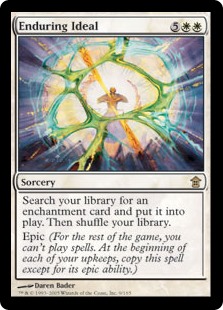 Enduring Ideal: I'm always nervous about playing synergies in Modern. Discard and removal are rampant, and you rarely have time to set up combos in the face of linear pressure. Following Scapeshift's example, Enduring Ideal is a "one-card combo" which effectively wins the game, albeit over a few turns instead of in a decisive Valakut blast. Ideal gets an edge because it's supplemented not by ramp, which does nothing to stop a stampeding Eldrazi horde, but by a gallery of enchantments eager and willing to hold the line. It also doesn't fold to the dreaded Thought-Knot Seer, courtesy of a turn zero Leyline or a turn two Halo. These maindecked defenses dramatically increase your chances of resolving a turn 4-5 Ideal. Once cast, Ideal immediately fetches whatever answer you need most, whether a Greater Auramancy to ensure security on a stable board or a Phyrexian Unlife to buy you a turn until the fatal Form of the Dragon upkeep. Or snag Nevermore to preempt an All is Dust!
Enduring Ideal: I'm always nervous about playing synergies in Modern. Discard and removal are rampant, and you rarely have time to set up combos in the face of linear pressure. Following Scapeshift's example, Enduring Ideal is a "one-card combo" which effectively wins the game, albeit over a few turns instead of in a decisive Valakut blast. Ideal gets an edge because it's supplemented not by ramp, which does nothing to stop a stampeding Eldrazi horde, but by a gallery of enchantments eager and willing to hold the line. It also doesn't fold to the dreaded Thought-Knot Seer, courtesy of a turn zero Leyline or a turn two Halo. These maindecked defenses dramatically increase your chances of resolving a turn 4-5 Ideal. Once cast, Ideal immediately fetches whatever answer you need most, whether a Greater Auramancy to ensure security on a stable board or a Phyrexian Unlife to buy you a turn until the fatal Form of the Dragon upkeep. Or snag Nevermore to preempt an All is Dust!
Phyrexian Unlife: Halfway to immortality! On its own, Unlife buys you at least a turn, absorbing everything from a five point jab for lethal to a million-and-one Restoration Angel copies. No matter how many attackers hit in one swing, they all deal damage simultaneously, all bring you below 0, and all fail to kill you. True, a subsequent hit will do the trick, but it better be for 10+ damage, which often buys more than enough time to get Form online off a subsequent Ideal trigger. Just be careful for Infect, where Unlife is useless, or something like Grapeshot with multiple damage instances.
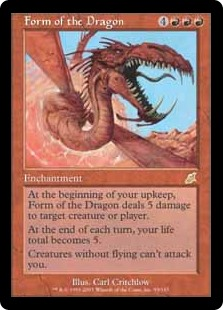 Form of the Dragon: Immortality attained. Form restores your life total to five every turn, which means an opponent needs to deal at least fifteen damage to bring you down: five to turn on Unlife's infect clause, and ten more to poison you to death. They'll also need to do it with fliers alone, and probably without targeting you (thanks, Leyline) or attacking with more than one creature (hats off, Prisons/Spheres). Good luck! Meanwhile, Form puts your opponent on a four turn clock, spitting for five damage each upkeep. This card alone is often a one-hit-KO against most Eldrazi builds, especially the Colorless and RG versions that lack a sizable airforce. Merfolk and Zoo are other decks that sit around staring stupidly at the Form, but be careful against flier-heavy Affinity.
Form of the Dragon: Immortality attained. Form restores your life total to five every turn, which means an opponent needs to deal at least fifteen damage to bring you down: five to turn on Unlife's infect clause, and ten more to poison you to death. They'll also need to do it with fliers alone, and probably without targeting you (thanks, Leyline) or attacking with more than one creature (hats off, Prisons/Spheres). Good luck! Meanwhile, Form puts your opponent on a four turn clock, spitting for five damage each upkeep. This card alone is often a one-hit-KO against most Eldrazi builds, especially the Colorless and RG versions that lack a sizable airforce. Merfolk and Zoo are other decks that sit around staring stupidly at the Form, but be careful against flier-heavy Affinity.
Luminarch Ascension: Sometimes you lose your Dragon-shifting enchantment to an untimely Thought-Knot Seer or a Thoughtseize into Scavenging Ooze. Sometimes you're not drawing Ideal and need another win condition on the battlefield. In these cases, Ascension takes advantage of a stagnant board and an excess of Nykthos mana to churn out an army of 4/4 Angels. There's anti-synergy between Ascension and Suppression Field, but you should have more than enough turns and resources to power through that tax. Some builds use Heliod, God of the Sun instead, but I find we have enough devotion to ensure he's a creature, which puts him in double-Dismember range (or, much worse, Path to Exile range). We also aren't maindecking the Porphyry Nodes plus Heliod combo, which also makes the God less viable.
Experienced prison players might argue against the sacrilegious Ascension clock, and with good reason. We don't necessarily need it to win, and can often get there on a locked down board alone: "decking" is a perfectly viable win condition if the Form can't go all the way. I love watching our opponents squirm as much as the next prison warden, but there's a real cost in tournaments for rounds going to time. If you don't want too many 1-1s or 1-0s on your match slips, you'll want a way to win in five minutes instead of 25. Ascension (or Heliod) fulfills that function.
Shields Up!
Leyline of Sanctity: Turn zero Leyline puts a pounding on a wide range of Modern strategies. The Eldrazi lose their invaluable Thought-Knot Seer interaction. Burn loses all its targeted damage. For BGx, it's the discard suite of Thoughtseize and Inquisition of Kozilek. Although there are certainly strategies which will ignore Leyline completely (Affinity, Infect, and Merfolk are the big three here), you're still generating Nykthos devotion and Sphere tax off a Leyline, and you can easily board them out for Games 2-3. When Leyline is good, however, it's gamebreaking. Eldrazi loses a high degree of security without the benefit of its turn 2-3 Thought-Knot, and Leyline sets up all the enchanted goodness to follow.
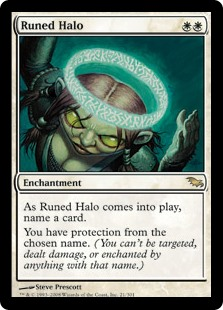 Runed Halo: At the risk of contributing to another spike, Runed Halo is one of the most undervalued cards in Modern. Our present metagame is packed with decks you can identify based on their turn one play. This means you can almost always name a relevant card for Halo to shutdown. If you're a Legacy player or old Extended veteran, you'll enjoy the Halo challenge as much as you love a good Cabal Therapy session: choose wisely and it negates something in every single matchup. Eldrazi, Infect, Affinity, Burn, and Merfolk (i.e., most of Modern's format) are heavy on playsets for Halo to answer, and often over-commit to a few damage sources. See Infect pledging to the turn two Blighted Agent or Affinity deploying a Master of Etherium. Moreover, none of these decks have reliable outs to an active Halo (short of the slow Ratchet Bomb pair in Eldrazi). Halo was horrible in an Abrupt Decay metagame. Know what's horrible against Eldrazi? Abrupt Decay. These factors all contribute to Halo being a deck and format all-star. Added bonus: in open linear metagames, Halo almost always turns off a win condition without the enemy's maindeck having an out.
Runed Halo: At the risk of contributing to another spike, Runed Halo is one of the most undervalued cards in Modern. Our present metagame is packed with decks you can identify based on their turn one play. This means you can almost always name a relevant card for Halo to shutdown. If you're a Legacy player or old Extended veteran, you'll enjoy the Halo challenge as much as you love a good Cabal Therapy session: choose wisely and it negates something in every single matchup. Eldrazi, Infect, Affinity, Burn, and Merfolk (i.e., most of Modern's format) are heavy on playsets for Halo to answer, and often over-commit to a few damage sources. See Infect pledging to the turn two Blighted Agent or Affinity deploying a Master of Etherium. Moreover, none of these decks have reliable outs to an active Halo (short of the slow Ratchet Bomb pair in Eldrazi). Halo was horrible in an Abrupt Decay metagame. Know what's horrible against Eldrazi? Abrupt Decay. These factors all contribute to Halo being a deck and format all-star. Added bonus: in open linear metagames, Halo almost always turns off a win condition without the enemy's maindeck having an out.
Ghostly Prison / Sphere of Safety: Many of Modern's top decks are threat-dense but mana source-light. Sure, they can power out clocks in a hurry, but it's often through a combination of cheap mana costs, cost reductions, and mana tricks like Aether Vial or Simian Spirit Guide. These same decks rely on constant pressure via additional threats and nonstop attacks to win the game. Prison and Sphere stop this approach cold. If you're trying to go wide, the turn three Prison funnels aggressors through a virtual Crawlspace as you try to pay the attacker tax. If you're hoping to maintain pressure, the Propaganda replacement forces you to choose between board development or damage. If you're thinking about manlands (Eldrazi, Affinity, and Infect generally are), Prison effectively doubles your mana requirements for each manland attack. And that's just a lone Prison! By the time you get multiples out, or big-daddy Sphere, it's a virtual Blazing Archon in a field that doesn't have the maindeck removal to get it off the board.
Suppression Field: Inkmoth Nexus, Ghost Quarter, Eye of Ugin, Mutavault, Blinkmoth Nexus, Spellskite, Cranial Plating, Arcbound Ravager, Ratchet Bomb. Field is a single card that stymies or outright neutralizes hallmark staples in about 50% of the format's top decks, just looking at Eldrazi and Affinity alone. Add fetchlands, Aether Vials, Viscera Seer activations, and Oblivion Stone/Karn Liberated abilities (for those still living #DatTronLife), and Field has never been better. Like Halo, this is another card which greatly benefits from the absence of Abrupt Decay.
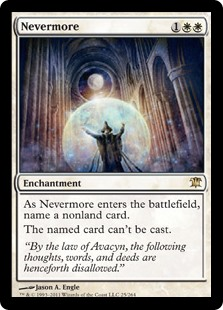 Nevermore: Quoth the Idealist, Nevermore! If you aren't making Edgar Allan Poe jests whenever playing the card, you're doing it wrong. Similar to the almighty Halo, Nevermore gets a lot better in metagames full of known decks with playsets of cards and established play-trees. It's much worse when metagames are wide open and packing strange singletons. Guess which one we're in today? Eldrazi may be taking on many color iterations, but the deck's core remains relatively stable. Affinity is, well, Affinity. That's about 50% of the MTGO field and 35% of the paper field where Nevermore has obvious targets even if you don't know a thing about how your opponent has tuned their particular build. The card gets significantly better against players you know, whether in a Top 8 where lists are published or a local event where you're familiar with your opposition. I'm only on a single copy because it's a bit passive and is not something you want to see when you're behind, but a grindier metagame could justify going up to two or even three.
Nevermore: Quoth the Idealist, Nevermore! If you aren't making Edgar Allan Poe jests whenever playing the card, you're doing it wrong. Similar to the almighty Halo, Nevermore gets a lot better in metagames full of known decks with playsets of cards and established play-trees. It's much worse when metagames are wide open and packing strange singletons. Guess which one we're in today? Eldrazi may be taking on many color iterations, but the deck's core remains relatively stable. Affinity is, well, Affinity. That's about 50% of the MTGO field and 35% of the paper field where Nevermore has obvious targets even if you don't know a thing about how your opponent has tuned their particular build. The card gets significantly better against players you know, whether in a Top 8 where lists are published or a local event where you're familiar with your opposition. I'm only on a single copy because it's a bit passive and is not something you want to see when you're behind, but a grindier metagame could justify going up to two or even three.
Greater Auramancy: If anyone is still playing Decay, Auramancy gives you a maindeck answer. It's also important against Chord of Calling and Collected Company players, who often tote lone enchantment destruction bullets in their decks (and the Eternal Witnesses to recur them). Don't forget World Breaker too! A pair of Auramancies renders your entire enchantment board immune to all this removal. Privileged Position gives more devotion with the same effect, but I prefer lower-cost enchantments to curve into bigger Nykthos plays on turn four or five.
Enduring Ideal veterans will note the absence of Ensnaring Bridge. I love my Stronghold Bridge playset, but am not crazy about it in this deck. With 25 lands, a bunch of expensive spells, and a weighty curve, we rarely have an empty hand. That's fine against Eldrazi's enormous beefcakes but a major problem against Affinity's, Infect's, Burn's, and Zoo's soldiers: remember, contrary to Reddit and forum opinion, the metagame isn't literally 100% Eldrazi. Bridge also doesn't contribute to either our Nykthos devotion or Sphere of Safety, which further pushes me away from the prison staple.
Clearing the Board
Oblivion Ring: Blows up all of Eldrazi's biggest sluggers, many of Affinity's scariest threats (especially Cranial Plating), and generally offers a versatile solution to random problems like opposing Leyline of Sanctity copies and Ratchet Bomb. Karn Liberated, Liliana of the Veil, and Oblivion Stone are also juicy targets! If you're facing endless swarms of Eldrazi and aggro, you can lower your Ring count in favor of Journey to Nowhere copies: both banish Reality Smasher without triggering a discard, but Journey gets you closer to parity with cheaper aggro adversaries.
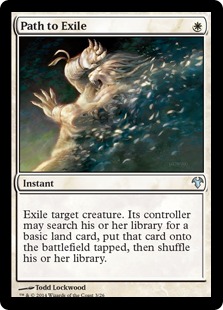 Path to Exile: I tried to get Porphyry Nodes, Journey to Nowhere, and additional Nevermores to work in this slot. Wrath of God was also a contender. Then I remembered that, as we talked about earlier, Modern isn't really 100% Eldrazi, even if it sometimes feels that way in comment sections. Path gives you an early response to something problematic like turn one Glistener Elf or turn two Inkmoth Nexus with Arcbound Ravager backup. It also tangles favorably with utility creatures like Aven Mindcensor, Melira, Sylvok Outcast, and Gaddock Teeg. Path is even passable against those Eldrazi goons, as long as you aren't aiming it at Reality Smashers. Although the instant doesn't contribute to devotion or Sphere's X, I've found this cost is worth the benefit of early interaction.
Path to Exile: I tried to get Porphyry Nodes, Journey to Nowhere, and additional Nevermores to work in this slot. Wrath of God was also a contender. Then I remembered that, as we talked about earlier, Modern isn't really 100% Eldrazi, even if it sometimes feels that way in comment sections. Path gives you an early response to something problematic like turn one Glistener Elf or turn two Inkmoth Nexus with Arcbound Ravager backup. It also tangles favorably with utility creatures like Aven Mindcensor, Melira, Sylvok Outcast, and Gaddock Teeg. Path is even passable against those Eldrazi goons, as long as you aren't aiming it at Reality Smashers. Although the instant doesn't contribute to devotion or Sphere's X, I've found this cost is worth the benefit of early interaction.
One of the strongest arguments against Path is its obnoxious interaction with Prison, Field, and other taxing effects, giving opponents more mana to pay for more of the effects we're trying to shut down. In that regard, it will remind you a lot of the frustrating but necessary Mana Leak/Path anti-synergy we see in many Jeskai and UW decks. Personally, I never found this to be a huge issue: Path is still saving you from taking damage, and those vaunted tax effects don't do anything if the lethal creature was getting paid through anyway. If you are super worried about this conflict of interests, however, you can easily swap Path out for either Lightning Bolt (bad against Eldrazi, better elsewhere) or Dismember (risky against aggressive, swarm strategies, but more attractive if you only need to nuke a few bombs)
Mana and Tricks
Mistveil Plains: Drew a win condition? No problem! Pitch it with either Peace of Mind or your natural discard step and then Mistveil it back on the bottom. Ideal will fetch it up during your next upkeep. Plains also prevents decking if you can't close a game with Form or Ascension and need to do your best Lantern Control imitation as your opponent slowly draws their way to oblivion.
Peace of Mind: Dropped in the early game, it contributes to Nykthos devotion and buys you multiple turns against damage-based strategies. Activated later, Peace of Mind lets you dump cards from your hand into your graveyard for Mistveil Plains recycling.
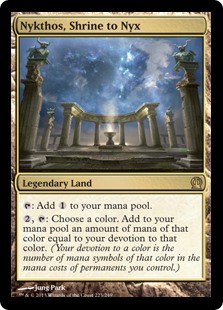 Nykthos, Shrine to Nyx: We may have lost Seething Song, but Nykthos serves as an acceleration upgrade in many respects. Imitating Song, it allows you to get the turn 4-5 Enduring Ideal in a format where turn four wins (or virtual wins) are at a premium. True, you'll need good draws to Ideal on turn four, but it's almost guaranteed on turn five with virtually any combination of enchantments on the battlefield. Unlike Song, Nykthos doesn't force you to run dead instants in a deck tight on slots, and generates usable stores of mana for Luminarch Ascension activations.
Nykthos, Shrine to Nyx: We may have lost Seething Song, but Nykthos serves as an acceleration upgrade in many respects. Imitating Song, it allows you to get the turn 4-5 Enduring Ideal in a format where turn four wins (or virtual wins) are at a premium. True, you'll need good draws to Ideal on turn four, but it's almost guaranteed on turn five with virtually any combination of enchantments on the battlefield. Unlike Song, Nykthos doesn't force you to run dead instants in a deck tight on slots, and generates usable stores of mana for Luminarch Ascension activations.
Temple of Triumph: We're not running cantrips or one-drops outside of Path to Exile, which opens up our turn one for something that Chalice of the Void won't affect. Temple smooths those critical, early draws so you can survive initial aggression. It's also a great topdeck when you're chilling behind Prisons and Spheres, just waiting for Ideal.
Sideboard Smorgasbord
If I sleeved up the deck for a tournament tomorrow, I'd expect a solid 50% of the field to be on Eldrazi, Affinity, Burn, and Merfolk (with most channeling their inner Cthulhu). Jund/Abzan and Abzan Company would definitely be there too, along with linear weirdos like Gruul Zoo, Suicide Shadow, Naya Company, Ad Nasueam, and Grishoalbrand. Add in the diehards trying to make blue-based control work (Jeskai, Esper, and UW primarily), and that's about 70%-80% of the format. I'd depend on catch-alls like Nevermore, Path to Exile, Runed Halo, and Wear // Tear for the rest, but with respect to those bigger matchups, here's how I'm outfitting the board.
Stony Silence: Between Prison, Halo, Field, and Path, the Game 1 Affinity matchup is actually better than it might seem. Silence swings it much further in our favor, especially when the opponent tries to bring in the already overworked Wear // Tears to combat our enchantments (if they are running them at all). Between Silence, maindeck and sideboarded Paths and Fields, plus the added Wear // Tears of your own, this matchup should be relatively comfortable.
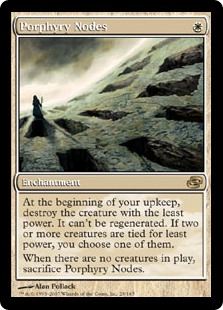 Porphyry Nodes: Nodes feels like maindeck material until you test it against Affinity or encounter a fast Eldrazi start. Manlands also give this card fits. In those situations, you really miss the surgical Path to Exiles. That said, against decks that can't vomit creatures like Affinity, and against those with less concentrated burst than Eldrazi, Nodes acts as a one-sided The Abyss that comes down on the first turn. Either an opponent plays around it and effectively waste their turn, or they play into it and incur massive losses. The effect is disgusting against decks which regularly deploy creatures but a) can't exert immediate and decisive pressure with their army or b) require a critical mass of attackers to exert that pressure. I'm up to three Nodes in the board to handle all the creature-based aggro decks and those further up the midrange spectrum.
Porphyry Nodes: Nodes feels like maindeck material until you test it against Affinity or encounter a fast Eldrazi start. Manlands also give this card fits. In those situations, you really miss the surgical Path to Exiles. That said, against decks that can't vomit creatures like Affinity, and against those with less concentrated burst than Eldrazi, Nodes acts as a one-sided The Abyss that comes down on the first turn. Either an opponent plays around it and effectively waste their turn, or they play into it and incur massive losses. The effect is disgusting against decks which regularly deploy creatures but a) can't exert immediate and decisive pressure with their army or b) require a critical mass of attackers to exert that pressure. I'm up to three Nodes in the board to handle all the creature-based aggro decks and those further up the midrange spectrum.
Dovescape / Boseiju, Who Shelters All: We're light to countermagic and control decks, and this pair helps plug those holes. In a control-heavy metagame (which we are definitely not a part of today), you'd probably need both of these in the maindeck with another 2-3 anti-control bullets in the sideboard: Defense Grid is very sweet in such a format.
Rest in Peace: Random graveyard decks are rampant in Modern, and Rest in Peace ensure these decks play fair in Games 2-3 (or don't play at all). These also help your control matchup if they're relying on Snapcaster Mage, not to mention all the unhappy Living End, Storm, Dredgevine, and Grixis players you'll crush along the way.
When sideboarding, your first question is always "Do I need my Leylines anymore?" When answering this question, think back to your extensive metagame research to predict who summons Thoughtseize for Games 2-3. Affinity, for instance, is a post-sideboard Thoughtseize regular, even if Leyline feels pretty anemic in Game 1. Path to Exile is another swift cut, notably if your opponent is too wide for Path to handle (BW Tokens comes to mind) or doesn't play meaningful creatures (Blue Moon). This will free up slots either for your matchup-specific inclusions or to shore up something in the maindeck which is working well (+1 Path, +1 Nevermore, +1 Field, etc.).
Believing in the Splash
There's nothing that says you need to go red-white for your own Enduring Ideal lists. Mono-white is the historic option, with blue, red, and many other colors all offering unique advantages. I'll consider a few of those options here, acknowledging this isn't an exhaustive list of splashes and off-color ideas.
Simian Spirit Guide and Blood Moon: Two can play at the fast-mana game, Eldrazi!  Modern's red Lotus Petal is great in a deck with a range of powerful three-mana cards that feel much more broken landing a turn earlier. The faster you plop a Ghostly Prison, the more damage you're going to prevent. Guide also improves your chances of the turn 4-5 Enduring Ideal. Once you're investing in the Ape, you could also go deeper into Blood Moon: a turn two Moon on the play is just as crippling today as it was a year ago. I've been known to enjoy some speedy Moons, but I admit Ideal isn't always the best place to deploy it. Moon shuts off your valuable Nykthos' without any major clock to capitalize on a disrupted opponent. Even so, the Moon effect can be crippling enough to get you to a natural turn 6-7 Ideal (six with Guide, seven alone). You can also use the bought-time to set up your defenses.
Modern's red Lotus Petal is great in a deck with a range of powerful three-mana cards that feel much more broken landing a turn earlier. The faster you plop a Ghostly Prison, the more damage you're going to prevent. Guide also improves your chances of the turn 4-5 Enduring Ideal. Once you're investing in the Ape, you could also go deeper into Blood Moon: a turn two Moon on the play is just as crippling today as it was a year ago. I've been known to enjoy some speedy Moons, but I admit Ideal isn't always the best place to deploy it. Moon shuts off your valuable Nykthos' without any major clock to capitalize on a disrupted opponent. Even so, the Moon effect can be crippling enough to get you to a natural turn 6-7 Ideal (six with Guide, seven alone). You can also use the bought-time to set up your defenses.
Guide / Chalice of the Void: A much better piece of technology, also borrowing from the Eldrazi playbook, is probably Chalice of the Void. You'd likely need to lose all the one-mana options in the maindeck and sideboard, but the added anti-linear power can help a lot. Affinity hates this at 0, and a variety of aggro enemies loath it at 1. As tempting as it might be to maindeck Chalice in your best Pro Tour homage, I would avoid it. Chalice does its best Null Rod flavor text impression against most Eldrazi builds (which make up most of Modern today), and many of the anti-Eldrazi decks are even evolving to contend with Chalice. This makes the artifact a powerful sideboard playset but a risky maindeck inclusion: make the deckbuilding call accordingly.
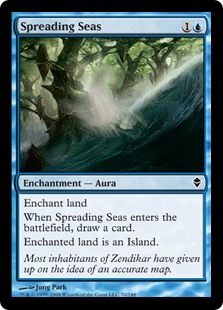 Detention Sphere and Spreading Seas: I'm in red to cast Form of the Dragon off weird boardstates and for sideboard flexibility in Wear // Tear (I originally had Pyroclasm there too, but felt comfortable enough against aggro to ditch it for now). If you want to lose the Wear // Tear versatility and double-down on your anti-Eldrazi crusade, blue pushes the matchup percentage into Infect vs. Ad Nauseam territory. The color gives you too many bullets for Eldrazi to dodge: Spreading Seas to cripple the manabase, Detention Sphere to detain all their redundant threats, and Copy Enchantment to do it all again. You'll need to rely on bounce in the sideboard in place of Wear // Tear's flexibility, but blue gives you enough advantages that this can be worth the exchange.
Detention Sphere and Spreading Seas: I'm in red to cast Form of the Dragon off weird boardstates and for sideboard flexibility in Wear // Tear (I originally had Pyroclasm there too, but felt comfortable enough against aggro to ditch it for now). If you want to lose the Wear // Tear versatility and double-down on your anti-Eldrazi crusade, blue pushes the matchup percentage into Infect vs. Ad Nauseam territory. The color gives you too many bullets for Eldrazi to dodge: Spreading Seas to cripple the manabase, Detention Sphere to detain all their redundant threats, and Copy Enchantment to do it all again. You'll need to rely on bounce in the sideboard in place of Wear // Tear's flexibility, but blue gives you enough advantages that this can be worth the exchange.
Utopia Sprawl and Helix Pinnacle (!): Green's biggest edge is, by far, turn one Utopia Sprawl. It's like red's Guide but permanent, a substantial edge in a deck that relies on regular mana output to play increasingly expensive threats. You can add Courser of Kruphix for the ramp angle (he also blunts damage-based aggro), although the Centaur loses some utility in a deck lacking fetchlands due to their anti-synergy with Field . Horizon Canopy makes up for that to some extent, combining with Temple of Plenty for even more land-based draw and selection. Of course, no green splash is complete without Helix Pinnacle, which beats even those Abzan Company players with more life than MTGO has Eldrazi collaborators. I'd be lying if I said Helix Pinnacle was a big reason to go green, but you'd also be lying if you tell me the card isn't awesome. Even if you aren't a Pinnacle believer, green still gets you Choke, Seal of Primordium, and the techy Spreading Algae (take that, you Urborg, Tomb of Yawgmoth abusers!) in your sideboard.
Living Up to your Ideals
Thanks for joining me today as we unpacked one of Modern's coolest and most underappreciated prison strategies. I know David probably had a rough time reading through this (his round three opponent, Tim Feldhaus, would be much prouder), but I'm hoping the rest of you got some deck or even individual card ideas for our current metagame. Even if you aren't interested in casing seven-mana sorcery bombs, technology like Ghostly Prison and Runed Halo can probably slot into many other lists you're working on.
What questions or comments do you have about the deck? Any cards you think I missed or builds you'd like me to discuss? Is there any interest in a follow-up article with discussion of matchups and similar, in-depth analysis? Have you been pioneering any other fringe Modern strategies in the Eldrazified and Affinitied Modern of today? I'm excited to see you all in the comment section, and will see you all again later in the week as we unpack some metagame statistics on our current format.




Nooo!! Sheridan, you’re calling too much attention to my deck, now there’s going to be all is dusts and fracturing gusts everywhere!
Jokes aside, thank you for writing about this archetype. The deck is a blast! Challenging, unique, it has some of the best tools out of the sideboard modern can offer, which make almost anything at least a “fair” match up. There’s many different variants of the deck, I’m a big fan of a naya & abzan builds that I play which utilize cards like faithless looting, Doomwake Giant, and Starfield of Nyx.
Heliod and porphyry nodes are a potent pairing. And I can’t sing the praises of suppression field enough. Runed halo is amazing in the current field of Eldrazi and infectors and greater auramancy (& bigger brother privileged position) can blank quite a few decks.
I think 3 leylines in the main is enough to see it when you need it, but I imagine that’s a meta call. Speaking of our meta, prison decks are notoriously bad against tron and other big mana decks (combo elves comes to mind) and I haven’t seen a ton of those online since Eldrazi started dominanting. So now, in my opinion, is the time for enchantments to shine.
Thanks for a great article, and thanks for calling attention to an under appreciated archetype.
P.S. If you find that during your testing control is an issue, try defense grids out of the board. Don’t forget that the deck can be built to support constellation cards like eidolon of Blossoms and Doomwake Giant as well. Seriously, multiple Doomwakes are lights out. And if you’re really into wacky ideas, manabarbs and pyrohemia…good times.
Glad you enjoyed the Enduring Ideal sampling! 3 Leyline is nice in certain metagames because you get an extra valuable slot while maintaining most of your consistency. I also enjoy Nodes and Heliod, but really felt a need for those instant-speed, targeted Paths more than I wanted the recurring Nodes removal. Also, Grids are the bomb against control.
I feel like this deck does have a great eldrazi matchup, but it needs a lot of help against other conventional modern strategies. I have played against prison decks not running enduring ideal as elves, affinity, and kiki chord. I have encountered very little resistance especially as elves and affinity. Its also a tough break that cards like fracturing gust and back to nature exist, so even if this deck or one like it takes up a reasonable meta share a few hate cards in the board will clear that up.
I want to believe, I really do. I just think the deck needs something to make it more proactive rather than relying on locking down your enemy before they kill you and hoping that they have nothing to deal with enchantments.
I had very similar thoughts about the deck. Is Starfield of Nyx or Grim Guardian too slow of a clock? Other thoughts for a clock include Yavimaya Enchantress, though that puts you in green, and/or Helm of the Gods + manlands. That gives you an even more absurdly powerful Celestial Colonnade.
Colonnade is great in the UW deck versions, but I’m always leery of too many creature-based win conditions. Starfield falls in this category too. Greater Auramancy makes something like Starfield much stronger, but you’re still turning on a lot of otherwise dead cards in an opponent’s hand. Virtual card advantage via removal-blanking is very real, and this deck can exploit that in a metagame packed with spells to kill creatures.
Elves is a bad matchup but rare enough that I’m not too worried. You can clean it up in the sideboard too so you’re at least closer to 45-55 and not 65-35 or something horrible. Affinity has been much better for me, especially because most Affinity builds gain very, very little after sideboarding whereas we gain a ton. I’m normally on board with making strategies more proactive, but something like Runed Halo is enough of a catchall to help you hold those early turns until you really establish the prison. Overall, it’s hardly Tier 1 material, but the deck has a lot of surprise power in this metagame!
I dare you, I double dare you, if I start playing this deck AGAIN because of you I will be mad (especially since I sold most of the stuff like 2 months ago, since I didn’t play with the deck since the Song ban).
Greetings,
Kathal
PS: However, well written but I still miss my petcard 3Sphere, always funny when opponents are desperately trying to get anything going.
Don’t buy back in yet! At least, unless the nostalgia factor is too strong to ignore and you have some money to spare on fringe Modern amusement.
Oh, you don’t even play Meishin, the Mind Cage o.O THAT is a lock down card.
Besides this, yeah, I have some spare money, but I’m currently foiling out Ritual Gifts for w/e reason (probably because the cards are nice in foil ^^ ).
Greetings,
Kathal
Kenshin, Did you even look at the primer? This wincon is the worst out of all the options. The one I helped brew for a friend isn’t an Enduring Ideal version though… Heliod and Throne for Wincons MB, Starfield SB.
Also, I have a WR version in my paper meta that uses Blood Moon and Chalice MB, it’s brutal.
I do like the Paths though, not sure why most on the primer do not run them… I added Mana Tithe to my friends mono W version for early tempo delay to get some enchants down.
Also, I thought nonteir 1 decks were frowned upon here… Can’t just brew up trash! Only react to successful decks then netdeck!… or is one win enough to do that. 🙂
Just poking fun, keep up the good work, man.
I really like playing the Boros version of prison. My chalice and blood moon with simian spirit guide is sexy for sure. The wincons are a lot less solid, though. Assemble is great, but I feel like running more than 2 leads to clunky starts, which you really want to avoid when setting up the early lock. gemstone caverns is also great and was tech I discovered before the pro tour.
That all said, the strongest draws are for sure a turn 1 chalice or other lock piece, but when I go to follow up with a turn 2 blood moon or really anything else, it just seems so much worse than a thought knot lol.
I am pretty sure the best follow up to a first turn lock piece is eldrazi, not more lock pieces XD
I love that kind of opening, but it’s more RW Lockdown to me than it is Enduring Ideal. Magus of the Tabernacle wants to join that party, as does Ensnaring Bridge, and at that point we no longer have the critical mass of enchantments to get things like Sphere or Nykthos to work. Great strategy, though! Just for a different deck.
Enchantress can definitely use stuff like Sigil, but it’s pretty bad in the Ideal version. Maindeck Moon and Chalice are also strong, but I think that lends itself more to the RW Lockdown style of play and less to the Enduring Ideal one. Great cards, just for a different deck. As for Tithe, I initially tested the card both maindecked and sideboarded until ditching it for Path. When it’s good it’s very good, but when it’s bad or mediocre it’s the last thing you want to see. On most turns, you’re using your mana to do something, which means Tithe is really at its best only on turn one. That said, I think Tithe would be great in a Jeskai Delver strategy where you do have early clocks that can exert pressure while you screen your win conditions with white Force Spike.
Thanks for the pointer to this interesting deck. One thing that wasn’t obvious to me when eldrazi burst onto the scene was how oppressive BGx decks were. They basically kept all synergy based decks out of the format unless they were super fast rush decks. Trying to get multiple synergistic cards into the board and to keep them on the board was a suckers game against a wall of discard and abrupt decay. With BGx everywhere there was no point in looking at tezz or enchantments.
If people don’t pull the trigger to soon on bans I’m excited to see a world with less BGx
Sacred mesa or Assemble the legion are worst than Luminach Ascensión?, Why?
I helped a friend of mine brew a mono-white enchantment prison deck that he used to shred his way through a small local tournamemt. The key card : Sunscour. 4 maindeck. That card is gross. The only truly bad matchups seem to be tron, which is non existent these days, and infect which can race. But even infect is probably no worse than 40/60, and gets better after board.
Fun to see others have snapped up Enduring Ideal as well! I’m currently trying out a blue splash because I feel that Copy Enchantment and Spreading Seas are two of the best enchantments for the deck.
I managed to qualify for the online PTQ with this deck:
https://dl.dropboxusercontent.com/u/6066501/ideal.jpg
I like very much the Magus of the Moat in the sideboard vs agro decks, for exemple Jund, Eldrazis, Merfolks and you can kill with the Luminach Ascensión and play the Enduring Ideal more fast with the Nikthos 🙂
Great article! It’s hard to find information on this deck right now (one of the best part about it, no one is prepared at all for it).
I have a couple questions I’m hoping someone could answer for me.
1. If I have a Runed Halo in play and I cast Copy Enchantment, do I get to name a new card or does it copy the Runed Halo target as well?
2. It looks like Suppression Field interacts with a lot of cards you play right now as well, has this ever hosed you? Is this far and away better then Stony Silence? I get that it has a wider array of cards it interacts with however I’m concerned about having to play around my own cards as well.
3. If you use the epic on Enduring Ideal to fetch Form of the Dragon, do you get to activate form as well that turn?
Thanks to anyone who answers 😀
Sheridan, what do you think about this deck now? I’m building it to play at my local events, it looks amazing on my meta.